Category Archive 'Sotheby’s'
09 May 2023

Steve McQueen’s 1967 Ferrari 275 GTB/4 by Scaglietti.
At Sotheby’s, Monterey, 18 – 19 August 2023, the Ferrari 275 GTB/4 once owned by the King of Cool. The front-engined grand tourer is expected to fetch serious money due to its provenance. Under the long and shapely hood of the Scaglietti-design is a 3.3-liter Colombo V12 engine good for 300 horsepower. It’s a rather unique car, having been repainted in stunning Chianti Red (over the original gold paint) and then fitted with the wheels and wing mirror from his convertible Ferrari 275 GTB/4 that he had crashed. This very car was restored to perfection by Ferrari Classiche between 2010 and 2013. It sold for $10 million at RM Sotheby’s flagship Monterey sale back in August 2014, and it should fetch an even larger sum when it hits the auction block again this August.
Sotheby’s listing.
04 Sep 2021
Sotheby’s will shortly be auctioning a really remarkable collection of the earliest hard-paste porcelain made in Europe, by the Meissen factory in Saxony created by Augustus the Strong.
Museum quality stuff worth a look.
21 Nov 2020

Sotheby’s Old Master Sculpture and Works of Art
November 24, 2020 — London
Lot 19 Property from an Important European Collection
Italian, late 17th/ early 18th century
Saint George and the Dragon
polychromed terracotta
43cm., 17in. (including lance)
Italian, late 17th/ early 18th century
Estimate: 4,000 – 6,000 GBP — $5,315.24 – $7,970.36
25 Oct 2019
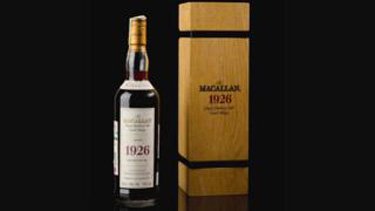
The BBC reports:
A rare bottle of Scotch whisky has sold for a world record £1.5m at auction in London.
The Macallan 1926 60-year-old single malt from cask number 263 had been estimated to sell for between £350,000 and £450,000.
Sotheby’s, which held the auction, did not release the identity of the buyer.
The previous auction record for a single bottle of Scotch was £1.2m, set by another bottle from the same cask in November last year.
Sotheby’s described The Macallan 1926 from cask number 263 as the “holy grail” of whisky.
The cask, which was distilled in 1926 and bottled in 1986, produced only 40 bottles.
The bottle featured at the auction as part of what Sotheby’s termed the “ultimate whisky collection”.
The entire collection of 467 bottles in 394 lots sold for £7,635,619 – about double the pre-auction estimate.
RTWT
04 Jun 2019


Big news from the BBC:
A medieval chess piece that was missing for almost 200 years had been unknowingly kept in a drawer by an Edinburgh family.
They had no idea that the object was one of the long-lost Lewis Chessmen – which could now fetch £1m at auction.
The chessmen were found on the Isle of Lewis in 1831 but the whereabouts of five pieces have remained a mystery.
The Edinburgh family’s grandfather, an antiques dealer, had bought the chess piece for £5 in 1964.
He had no idea of the significance of the 8.8cm piece (3.5in), made from walrus ivory, which he passed down to his family.
They have looked after it for 55 years without realising its importance, before taking it to Sotheby’s auction house in London. …
Sotheby’s expert Alexander Kader, who examined the piece for the family, said his “jaw dropped” when he realised what they had in their possession.
“They brought it in for assessment,” he said. “That happens every day. Our doors are open for free valuations.
“We get called down to the counter and have no idea what we are going to see. More often than not, it’s not worth very much.
“I said, ‘Oh my goodness, it’s one of the Lewis Chessmen’.”
Mr Kader, Sotheby’s co-worldwide head of European sculpture and works of art, said the family, who want to remain anonymous, were “quite amazed”.
“It’s a little bit bashed up. It has lost its left eye. But that kind of weather-beaten, weary warrior added to its charm,” he said.
Despite not knowing its significance, the late 12th/early 13th Century chess piece had been “treasured” by the family.
The current owner’s late mother believed it “almost had magical qualities”.
A family spokesman said in a statement: “My grandfather was an antiques dealer based in Edinburgh, and in 1964 he purchased an ivory chessman from another Edinburgh dealer.
“It was catalogued in his purchase ledger that he had bought an ‘Antique Walrus Tusk Warrior Chessman’.
“From this description it can be assumed that he was unaware he had purchased an important historic artefact.
“It was stored away in his home and then when my grandfather died my mother inherited the chess piece.
“My mother was very fond of the Chessman as she admired its intricacy and quirkiness. She believed that it was special and thought perhaps it could even have had some magical significance.
“For many years it resided in a drawer in her home where it had been carefully wrapped in a small bag. From time to time, she would remove the chess piece from the drawer in order to appreciate its uniqueness.”
The Lewis Chessmen set includes seated kings and queens, bishops, knights and standing warders and pawns. Some 82 pieces are now in the British Museum and 11 pieces held by the National Museum of Scotland. As well as the chess pieces, the hoard includes 14 “tablemen” gaming pieces and a buckle.
Since the hoard was uncovered in 1831, one knight and four warders have been missing from the four combined chess sets.
The newly-discovered piece is a warder, a man with helmet, shield and sword and the equivalent of a rook on a modern chess board, which “has immense character and power”.
The discovery of the hoard remains shrouded in mystery, with stories of it being dug up by a cow grazing on sandy banks.
It is thought it was buried shortly after the objects were made, possibly by a merchant to avoid taxes after being shipwrecked, and so remained underground for 500 years.
Mr Kader, who has kept the discovery under wraps for six months while authenticating the find, said: “We can safely say that a million pounds will transform the seller’s life.”
He added: “There are still four out there somewhere. It might take another 150 years for another one to pop up.”
——————-
Sotheby’s write-up.
15 Oct 2018

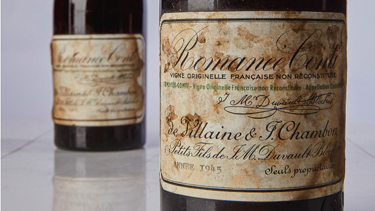
Quartzy:
As Europe nursed its wounds right after the Second World War’s end in 1945, top Burgundy producer Romanee-Conti made just 600 bottles of dark red nectar before pulling up its vines for replanting.
Yesterday (Oct. 13), two of those 600 were sold in separate auction bids for a total of just over $1 million at Sothebys in New York. Three more bottles from the 1937 vintage went for a total of $930,000.
All five bottles beat the previous record for most expensive bottle of wine of any size, a $304,375 six-liter bottle of Cheval-Blanc 1947, sold in Geneva in 2010. (The records don’t include bottles auctioned for charity.) The two 1945 bottles also eclipsed the previous record for a standard-sized wine bottle—$233,000 at a Hong Kong auction in 2010.
The highest bid was for the first bottle from 1945, which went for $558,000. That’s 17 times more expensive than Sothebys’ upper estimate of $32,000. A few minutes later, the second bottle of 1945 sold for $496,000. Three magnums of the 1937 were then sold for $310,000 each, having been given an upper estimate of $40,000.
The total collection, from the personal cellar of wine producer Robert Drouhin, sold for $7.3 million. Nine of its 100 bottles went for six-figure sums.
The 1945 vintage is “rare and wonderful,†Serena Sutcliffe, head of Sothebys international wine department, wrote in the lot notes. “The best bottles are so concentrated and exotic, with seemingly everlasting power—a wine at peace with itself.â€
RTWT
07 Oct 2018


—————————–
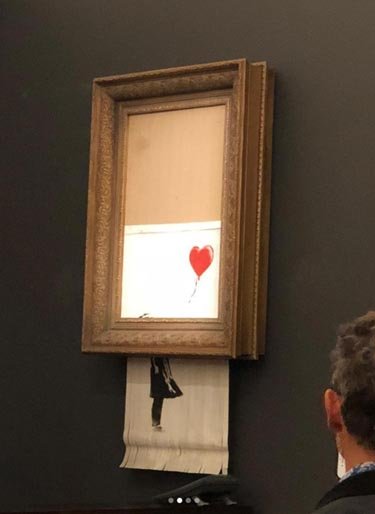
Hyperallergenic:
A Banksy artwork “self-destructed†at a Friday night Sotheby’s auction in London.
“Girl with a Balloon†(2006) was the final lot of the evening sale at Sotheby’s and ended things off with an impressive final price of £953,829 (~$1,251,423), or £1,042,000 with buyer’s premium (~$1,367,104). Maybe people should’ve suspected something was suspicious when the artwork sold for the exact same figure as the artist’s previous auction record in 2008.
Robert Casterline of Casterline Goodman gallery was in attendance and told Hyperallergic what happened next. He explained there was “complete confusion†and an “alarm inside the frame started going off as the gavel went down.â€
“[It] sold for over a million dollars and as we sat there…the painting started moving,†he said, and added that the painting’s frame, also made by Banksy, acted as a shredder and started to cut the canvas into strips. “[It was] all out confusion then complete excitement,†he explained.
Anny Shaw of the Art Newspaper spoke to Alex Branczik, the auction house’s head of contemporary art for Europe, who seemed as surprised as anyone. “It appears we just got Banksy-ed,†he said immediately after the sale. He is arguably the greatest British street artist, and tonight we saw a little piece of Banksy genius,†he said, adding that he was “not in on the ruse.â€
Shaw also reports that there was speculation “that the elusive artist had himself pressed the button that destroyed the work.â€
But is the work destroyed? Or is it transformed? Even Branczik isn’t sure. “You could argue that the work is now more valuable,†Branczik said.
RTWT
——————————-
12 Jan 2018

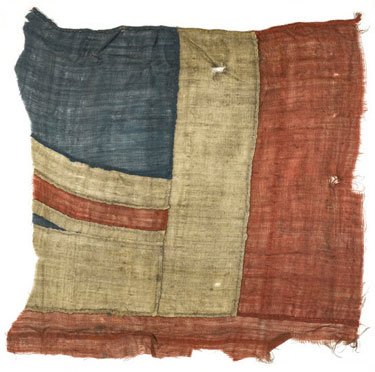
At Sotheby’s London, “Of Royal and Noble Descent” Auction, Lot 116:
AN EXCEPTIONALLY LARGE FRAGMENT OF THE UNION FLAG, BELIEVED TO HAVE FLOWN FROM HMS VICTORY AT THE BATTLE OF TRAFALGAR
comprising eight panels of red, white and blue hand-woven woollen bunting, hand-stitched together to form part of the bottom-right (or top-left) quadrant of the Union flag, hemmed at the bottom (or top), hem turned over enclosing c.460mm of twine, crudely torn at the edges, c.860 x 920 mm, mounted, framed, and glazed (frame size 1125 x 1125mm), c.1801-1805
AN EVOCATIVE AND IMPRESSIVE RELIC OF NELSON AND TRAFALGAR. Nelson’s ships sailed into battle at Trafalgar flying the national flag rather than just their squadron colours, as a result of an order issued by Nelson in the days before the battle: “When in the presence of an Enemy, all the Ships under my command are to bear white Colours [i.e. St George’s Ensign], and a Union Jack is to be suspended from the fore top-gallant stay” (10 October 1805). HMS Victory consequently flew two Union flags and a St George’s Ensign, which were returned to England with the ship and the body of Nelson.
These battle ensigns, unique patriotic mementoes of Nelson’s final and greatest victory, were later woven into the solemn and dignified series of ceremonials that marked his state funeral in January 1806. The body lay in state at the Painted Hall at Greenwich for four days before processing upriver in a funeral barge with a flotilla of naval escorts, disembarking at Whitehall Stairs and resting overnight in the Admiralty. The following day, 9 January, a vast procession followed Nelson’s remains to St Paul’s Cathedral, the site of the funeral. Incorporated into the funeral cortege was a group of 48 seamen and Marines from HMS Victory, who bore with them the ship’s three battle ensigns and were, according to one eyewitness, “repeatedly and almost continually cheered as they passed along”. At the conclusion of the funeral service, with the coffin placed at the heart of the cathedral beneath Wren’s great dome, the sailors were supposed to fold the flags and place them reverently on the coffin. The conclusion of the service, in fact, played out rather differently, as described by the Naval Chronicle (1806): “the Comptroller, Treasurer and Steward of his Lordship’s household then broke their staves, and gave the pieces to Garter, who threw then into the grave, in which all the flags of the Victory, furled up by the sailors were deposited – These brave fellows, however, desirous of retaining some memorials of their great and favourite commander, had torn off a considerable part of the largest flag, of which most of them obtained a portion.” According to one acute observer: “That was Nelson: the rest was so much the Herald’s office.” (See The Nelson Companion, ed. White (1995), pp8-14)
Most of the surviving fragments of the Victory’s flags are much smaller than the current piece. Small fragments of white and blue bunting, no more than 12cm in length, have appeared at auction (e.g. Bonhams, 28 September 2004, lot 117; Sotheby’s, 17 December 2009, lot 9) and other similar fragments are found at the National Maritime Museum and other institutional collections. Only two complete Union jacks that were used as battle ensigns at Trafalgar survive: one from HMS Minotaur (National Maritime Museum), the other from HMS Spartiate (sold at auction by Charles Miller Ltd., 21 October 2009, lot 53, £384,000).
Estimate: 80,000 — 100,000 GBP — 105,376 – 131,720 USD
26 Nov 2013

Maine Antique Digest runs a monthly Letter from London column which describes some of the more interesting items appearing in recent sales.
At Sotheby’s “Art of Imperial India” sale, London, October 9th last, was sold a captured and re-hilted British sword decorated with the bubri symbol of Tipu Sahib, “the Tiger of Mysore,” one of the most formidable enemies of British rule in India, slain finally defending his own fortress at the Siege of Seringapatam in 1799.
Tipu is quoted as saying: “Better to die like a soldier than live a miserable life dependent on the infidels… I would rather live two days as a tiger, than two hundred years as a sheep.”
Interestingly, this sword was not taken at Seringapatnam, as it comes from the estate of Sir Charles Malet, Bart., who had left India a year before the siege. It was probably a trophy of the Third Anglo-Mysore War.
The sword sold for $157,695 (98,500 GBP). Lot 249.

28 Mar 2013


DING BOWL, NORTHERN SONG DYNASTY
Kovel’s reports:
The big network news story last week was the $2.22 million bowl sold by Sotheby’s in London [sic: the sale was in New York] on March 19, 2013. A New York couple had bought the bowl in 2007 for $3. Here are the facts culled from many news stories: The bowl is 5 inches in diameter. It was made during the Northern Song Dynasty (960-1127). Only one other like it is known and that one is in the British Museum. The expensive bowl is white and has a molded leaf decoration outside and an etched flower design inside. The sellers displayed the bowl either on their mantel or a table until recently, when they noticed the high prices being paid for Chinese ceramics. So they had the bowl appraised and Sotheby’s listed it for sale at $200,000 to $300,000. When the owners were informed the bowl sold for millions, they emailed back “WOW!!!” The buyer, one of four serious bidders, is considered by many to be the world’s foremost dealer in Oriental art. He says he is sure he will be able to sell the bowl.
Sotheby’s Fine Chinese Ceramics & Works of Art sale, New York, March 19, lot 94:
PROPERTY FROM A NEW YORK STATE FAMILY COLLECTION
A RARE AND IMPORTANT ‘DING’ BOWL
NORTHERN SONG DYNASTY
Estimate: 200,000 – 300,000 USD
LOT SOLD. 2,225,000 USD (Hammer Price with Buyer’s Premium)
the finely potted body of slightly rounded and steep flared form rising from a short spreading foot to an upright rim, deftly carved to the interior with scrolling leafy lotus sprays, the exterior carved and molded with three rows of overlapping upright leaves, applied overall with an even ivory-colored glaze with characteristic teardrops at the base, the rim of the bowl and the footrim left unglazed showing the fine compact body beneath
Diameter 5 3/8 in., 13.4 cm
Sotheby’s blog did a nice write-up.
The British Museum tells us that these ceramics were “produced at the Ding kilns in Hebei province, northern China, whose white porcelains were considered one of the ‘five great wares’ of the Song Dynasty (AD 960-1279 AD).”

DING BOWL, NORTHERN SONG DYNASTY
11 Jul 2012

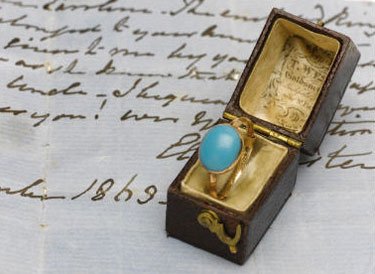
A turquoise and gold ring once belonging to Jane Austen sold yesterday at Sotheby’s in London for 152,450 pounds ($236,000) more than five times its pre-sale estimate.
Sotheby’s Sale L12404, Lot 59.
The Telegraph reported:
The ring, which featured a large oval turquoise gemstone, was sold alongside a handwritten letter by her sister-in-law Eleanor Austen bequeathing the rare jewel to her niece Caroline.
The note, dated 1863, confirms the item belonged to the 19th-century British author.
“My dear Caroline,” Eleanor wrote. “The enclosed ring once belonged to your Aunt Jane. It was given to me by your Aunt Cassandra as soon as she knew that I was engaged to your uncle. I bequeath it to you. God bless you!”
The rare piece is the latest in a series of the writer’s pieces to be sold at auction.
Last year, a handwritten draft of an unpublished Jane Austen book was sold for just over £1 million. It was said to be the earliest surviving manuscript of the author’s work.
The sale of Miss Austen’s jewellery at more than five times its estimate yesterday appeared to demonstrate that fascination with the Pride and Prejudice writer has yet to wane.
After a tense battle between eight bidders, the item was eventually sold at £152,450 to an anonymous private collector over the phone.
“Jane Austen’s simple and modest ring is a wonderfully intimate and evocative possession,” said Dr Gabriel Heaton, a manuscript specialist at Sotheby’s auction house.
10 Jun 2009


The local historical society atBerwick, Pennsylvania, a borough of 10,000 people in largely rural Columbia County, was inventorying its collection of Early America almanacs and discovered it possessed a rare 1733 first annual edition of Benjamin Franklin‘s Poor Richard’s Almanack.
The almanac, bound with several others, proved authentic, and was sold yesterday at Sotheby’s, bringing $556,500, the second largest price ever paid at auction for an American book. The record holder remains George Washington’s copy of the Federalist Papers also sold by Sotheby’s in 1990 for $1.4 million.
Whatever will the historical society do with so much money?
Some news agency‘s account.
I know myself of a county courthouse in Pennsylvania where original documents signed by Benjamin Franklin in his capacity as secretary of the Commonwealth of Pennsylvania are still sitting unrecognized in the county clerk’s office. I could have pointed out their value, but I kind of like the idea of their being in the same place they’ve always been.
/div>

Feeds
|

















